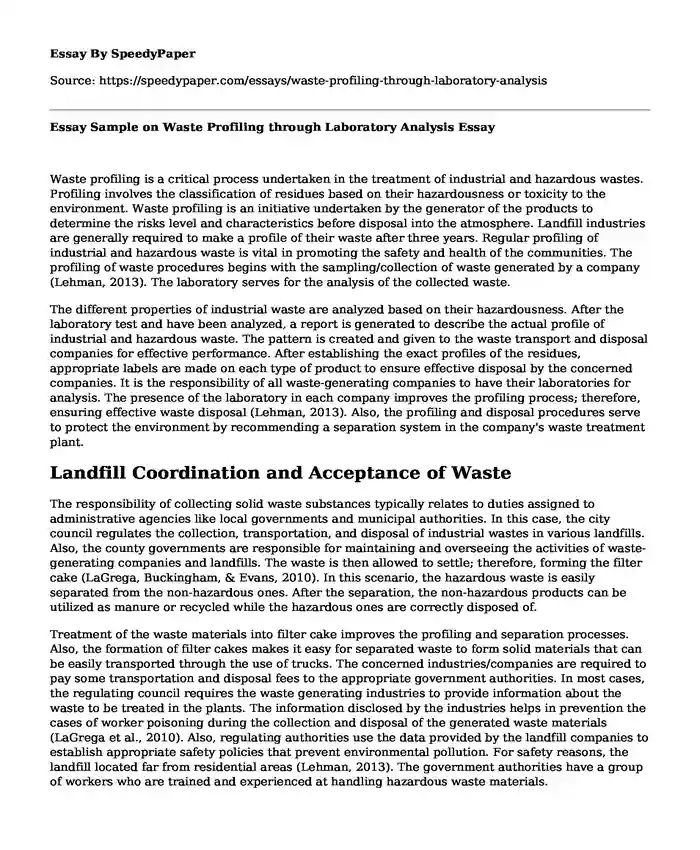Waste profiling is a critical process undertaken in the treatment of industrial and hazardous wastes. Profiling involves the classification of residues based on their hazardousness or toxicity to the environment. Waste profiling is an initiative undertaken by the generator of the products to determine the risks level and characteristics before disposal into the atmosphere. Landfill industries are generally required to make a profile of their waste after three years. Regular profiling of industrial and hazardous waste is vital in promoting the safety and health of the communities. The profiling of waste procedures begins with the sampling/collection of waste generated by a company (Lehman, 2013). The laboratory serves for the analysis of the collected waste.
The different properties of industrial waste are analyzed based on their hazardousness. After the laboratory test and have been analyzed, a report is generated to describe the actual profile of industrial and hazardous waste. The pattern is created and given to the waste transport and disposal companies for effective performance. After establishing the exact profiles of the residues, appropriate labels are made on each type of product to ensure effective disposal by the concerned companies. It is the responsibility of all waste-generating companies to have their laboratories for analysis. The presence of the laboratory in each company improves the profiling process; therefore, ensuring effective waste disposal (Lehman, 2013). Also, the profiling and disposal procedures serve to protect the environment by recommending a separation system in the company's waste treatment plant.
Landfill Coordination and Acceptance of Waste
The responsibility of collecting solid waste substances typically relates to duties assigned to administrative agencies like local governments and municipal authorities. In this case, the city council regulates the collection, transportation, and disposal of industrial wastes in various landfills. Also, the county governments are responsible for maintaining and overseeing the activities of waste-generating companies and landfills. The waste is then allowed to settle; therefore, forming the filter cake (LaGrega, Buckingham, & Evans, 2010). In this scenario, the hazardous waste is easily separated from the non-hazardous ones. After the separation, the non-hazardous products can be utilized as manure or recycled while the hazardous ones are correctly disposed of.
Treatment of the waste materials into filter cake improves the profiling and separation processes. Also, the formation of filter cakes makes it easy for separated waste to form solid materials that can be easily transported through the use of trucks. The concerned industries/companies are required to pay some transportation and disposal fees to the appropriate government authorities. In most cases, the regulating council requires the waste generating industries to provide information about the waste to be treated in the plants. The information disclosed by the industries helps in prevention the cases of worker poisoning during the collection and disposal of the generated waste materials (LaGrega et al., 2010). Also, regulating authorities use the data provided by the landfill companies to establish appropriate safety policies that prevent environmental pollution. For safety reasons, the landfill located far from residential areas (Lehman, 2013). The government authorities have a group of workers who are trained and experienced at handling hazardous waste materials.
References
LaGrega, M. D., Buckingham, P. L., & Evans, J. C. (2010). Hazardous waste management. Waveland Press. Retrieved from: https://scholar.google.com/scholar?hl=en&as_sdt=0%2C5&q=LaGrega%2C+M.+D.%2C+Buckingham%2C+P.+L.%2C+%26+Evans%2C+J.+C.+%282010%29.+Hazardous+waste+management.+Waveland+Press.&btnG=
Lehman, J. P. (Ed.). (2013). Hazardous waste disposal (Vol. 4). Springer Science & Business Media. Retrieved from: https://books.google.co.ke/books?hl=en&lr=&id=18fkBwAAQBAJ&oi=fnd&pg=PA3&dq=Lehman,+J.+P.+(Ed.).+(2013).+Hazardous+waste+disposal+(Vol.+4).+Springer+Science+%26+Business+Media.&ots=_GQ-g4qjtx&sig=iYf0k5jXhSsSr9gWLlevhQ0HnFQ&redir_esc=y#v=onepage&q&f=false
Cite this page
Essay Sample on Waste Profiling through Laboratory Analysis. (2023, Feb 22). Retrieved from https://speedypaper.net/essays/waste-profiling-through-laboratory-analysis
Request Removal
If you are the original author of this essay and no longer wish to have it published on the SpeedyPaper website, please click below to request its removal:
- Reflection Essay Sample about Project Management
- Free Essay Sample on Apple's Marketing Strategy
- Dietary Prevention of Cancer, Research Paper Sample
- Free Essay Example on Harm Related Behaviour
- Report on Big Data Analytics with Hive, Free Example
- Essay Sample on Supply Chain and Acquisition
- Oil & Gas: Impact of Covid-19 & Recovery Prospects - Paper Example
Popular categories





